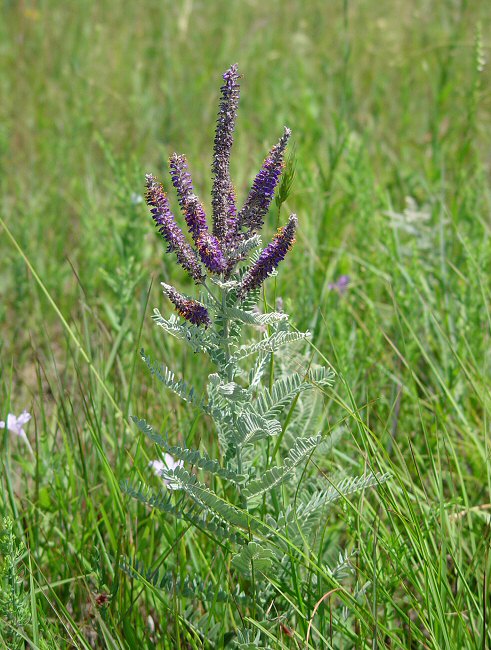Amorpha canescens Pursh
Lead Plant

Native
CC = 8
CW = 5
MOC = 77
© DETenaglia
Amorpha canescens PurshLead Plant | |
 |
Native CC = 8 CW = 5 MOC = 77 |
© DETenaglia |
|
Family - Fabaceae/Faboideae Habit - Small shrubs or subshrubs, from a knotty rootstock with a deep thick taproot. Stems - Ascending to erect, to 70 cm, unbranched or sparsely branched, usually densely pubescent with short whitish to gray woolly hairs, rarely nearly glabrous, also sparsely and obscurely glandular.
Leaves - Alternate, odd-pinnately compound, stipulate. Stipules linear, purplish, deciduous, to 3 mm long. Leaves with 29-41 leaflets, subsessile, the petiole 0.5-1.0 mm long, much shorter than the width of the lowest leaflet, the rachis 8-13 cm long, the petiole and rachis densely pubescent with short whitish to gray woolly hairs. Leaflets 9-17 mm long, 4-8 mm wide, ovate-oblong to elliptic, rounded to cordate at the base and with a stalk 0.5-1.0 mm long, rounded or abruptly short-tapered to a minute sharp point at the tip, the margins entire, both surfaces sparsely to more commonly densely pubescent with short whitish to gray woolly hairs, also inconspicuously gland-dotted.
Inflorescences - Terminal and axillary racemes 8-17 cm long, commonly in clusters of 7-9, the flower stalks 0.8-1.2 mm long, the axes canescent.
Flowers - Calyces 5-lobed, the tube 1.5-2.0 mm long, the lobes 1.5-2.0 mm long. Corollas not papilionaceous, the single petal 4-5 mm long, 2.0-2.5 mm wide, obovate, folded around stamens and pistil, bluish purple. Stamens 10, exserted, the free portion of the filaments 4-5 mm long, the anthers 0.3-0.5 mm long, yellow. Ovary superior, 1.0-1.5 mm long, densely hairy, the style 2-3 mm long, glabrous or densely hairy. Stigma glabrous, 3-lobed, purplish.
Fruits - Modified legumes 3-4 mm long, 1.2-1.5 mm wide, slightly flattened, exserted beyond the persistent calyx tube, hairy and gland-dotted, 1-seeded. Seeds 2.0-2.4 mm long, 1.0-1.4 mm wide, olive to reddish brown.
Flowering - May - August. Habitat - Upland prairies, loess hill prairies, glades, tops of bluffs, savannas, and openings of dry upland forests, pastures, railroads, roadsides. Also cultivated. Origin - Native to the U.S. Lookalikes - Tephrosia virginiana, when not in flower. Other info. - This species of Amorpha is easily recognized when flowering by its dense canescence (conspicuous gray hairiness) and distinctive inflorescences. Non-flowering specimens can appear similar to another legume, Tephrosia virginiana (goat's rue). The two can be reliable distinguished by the shape of the leaflet bases: in A. canescens these are rounded or slightly cordate, whereas in T. virginiana they are tapered. The presence or absence of a mucro (minute spiny tip) on the leaflets is less reliable. Photographs taken at Lichen Glade, St. Clair County, MO., 6-16-05 and at Indigo Prairie Conservation Area, Dade County, MO., 6-18-05 (DETenaglia); also at St. Joe State Park, St. Francois County, MO, 5-14-2012, and Little Lost Creek Conservation Area, Warren County, MO, 6-9-2017 and 7-7-2020 (SRTurner). |